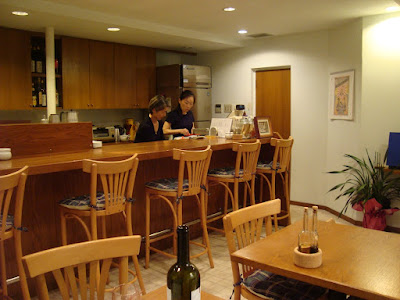 Last week was sports day (undo kai) at Isurgi Elementary. If I recall correctly our sports day was on the back lawn of Brampton Abbotts village hall, about 60 kids in total, all lining up to compete in egg & spoon, three legged and the sack race. Mum?
Last week was sports day (undo kai) at Isurgi Elementary. If I recall correctly our sports day was on the back lawn of Brampton Abbotts village hall, about 60 kids in total, all lining up to compete in egg & spoon, three legged and the sack race. Mum?Boy, this couldn’t be more different. Parents, grandparents , aunties & uncles arrive in hoards armed with picnic hampers, blankets, umbrellas for the shade and their professional Nikon D60’s (come on, they’re Japanese!)
The day (yes an entire day devoted to the event) kicks off at 9am with 500 kids in total dancing with military precision to a welcome tune on the gigantic sand racing track in front of the school. This is followed by singing the school anthem whilst flags representing Japan, Oyabe City and the school logo are hoisted up.
 The important people of Oyabe (I’m presuming) all line up and a lot of bowing goes on. All so formal! See piccie above.
The important people of Oyabe (I’m presuming) all line up and a lot of bowing goes on. All so formal! See piccie above.Races ranged from the run of the mill 100m, tug of war (Japan name), obstacle courses to this battle game (Japanese name) where 3 pupils carry a 4th pupil (I’ll call him the king) on their shoulders.
The aim of the battle was to knock the cap off the opponent king and cross the line. It was hilarious to watch and by far the most exciting thing I watched all day.
Pupils' pre-exercise warm up video
The whole day was orchestrated to perfection. How? Because they’ve been rehearsing the songs, marches, races, flag hoisting for weeks on end. When I was arriving at school at 8am, they’re already all out there on the track. Poor little mites!! It seems to be the done thing here in Japan. At 6.30am when I’m walking to the train station I pass little elementary kids on their way to school, yes THAT early. No wonder all the high school kids fall asleep on the train and in the classroom. Their schedules are intensive, early starts, after school clubs or juku (cram schools to learn English) and more clubs at the weekend. Hard, long days.
Anyway, I’m digressing. Great day out. I was even involved in one of the obstacle races, having to play janken (scissors, paper, stone) with the 2nd graders. Fun, fun, fun and took me back..!
Me playing Janken in video below (with my really poor "Saisho wa guu jankenpon" Japanese lingo)

















 So having not yet been to the nearest beach to Kanazawa (Uchinada) I jumped at the chance of making a trip there during Golden Week for the world famous (apparently..) kite festival. The trip to Uchinada Town is really easy, just hop on the Hokutetsu train (note that the platform is down those huge escalators at Kanazawa station- we ended up walking around KZ station for half an hour looking for the platform) The ride takes about 20 mins and you can't go wrong as Uchinada is the last stop. When you get to Uchinada, come out of the station, hook a left and walk straight (up hill) for about 15 mins and you'll end up at the beach. Easy!
So having not yet been to the nearest beach to Kanazawa (Uchinada) I jumped at the chance of making a trip there during Golden Week for the world famous (apparently..) kite festival. The trip to Uchinada Town is really easy, just hop on the Hokutetsu train (note that the platform is down those huge escalators at Kanazawa station- we ended up walking around KZ station for half an hour looking for the platform) The ride takes about 20 mins and you can't go wrong as Uchinada is the last stop. When you get to Uchinada, come out of the station, hook a left and walk straight (up hill) for about 15 mins and you'll end up at the beach. Easy!








 Well I would have missed this festival if it hadn't been for a quick conversation with my Kancho Sensei at Isurugi Elementary. He showed me one of the posters in the corridor all in kanji which I had walked past so many times and didn't really pay attention to as I didn't understand the Kanji. It was advertising the Hikiyama festival, held each year on Showa Day a public holiday to celebrate the birthday of former Emporer Showa. Forgive my ignorance but right now I'm not sure who he is.
Well I would have missed this festival if it hadn't been for a quick conversation with my Kancho Sensei at Isurugi Elementary. He showed me one of the posters in the corridor all in kanji which I had walked past so many times and didn't really pay attention to as I didn't understand the Kanji. It was advertising the Hikiyama festival, held each year on Showa Day a public holiday to celebrate the birthday of former Emporer Showa. Forgive my ignorance but right now I'm not sure who he is. nd found a good vie
nd found a good vie